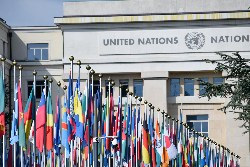Nepal: Deepening Uncertainty Amid U.S. Dilemma
Nepal: Deepening Uncertainty Amid U.S. Dilemma
By Sanjay Upadhya
The Maoist insurgency raging in Nepal has posed a unique challenge to the United States: Reverberations of the Cold War-era Red Scare have combined with the imperatives of the ongoing War on Terror. The possibility of the world’s first communist takeover since the collapse of the Eastern bloc – and that, too, under the auspices of a group the State Department has designated a terrorist organization – has produced palpable anxiety.
If anything, from Washington’s perspective, that anxiety has deepened in the aftermath of King Gyanendra’s February 1 takeover of full executive powers. During a House of Representatives subcommittee hearing on South Asia earlier this month, Dana Robert Dillon, a senior policy analyst with the conservative Heritage Foundation, raised the possibility of Kathmandu falling to the Maoist rebels.
At the same briefing, U.S. Assistant Secretary of State for South Asia, Christina Rocca, just back from a trip to the kingdom, painted a bleak picture. While desisting from making a categorical prediction, Rocca said a Maoist takeover would have profoundly negative effects both in Nepal and in the region. The Maoists must renounce violence and engage in a political process to resolve their grievances, Rocca added in what has become a familiar U.S. refrain.
The theme was picked up last week by US ambassador to Nepal James F. Moriarty at a conference in Hawaii. A victory for Maoist insurgents in Nepal would cause a humanitarian disaster in the Himalayan nation and acutely worry India, the U.S. envoy said at a public program at the East-West Center in Honolulu.
Elements of Moriarty’s three-point reconciliation plan -- ensuring a fair degree of unity among the legitimate political forces on how to deal with the Maoists; putting pressure from the international community on the Maoists to come to the negotiating table and re-enter the political mainstream; and making the insurgents believe they will not be able to win militarily – have been on the table since October 2002, when King Gyanendra first began assuming a more direct role in Nepalese politics.
What is chillingly revealing is the grimness of Moriarty’s portrait of a Maoist Nepal. A Maoist victory, he said, would put power in the hands of a brutal regime, adding it would advocate collectivization of agriculture, re-education of class enemies and export of revolution. Moriarty warned that a Maoist victory would also send millions of refugees across the border into neighboring India. Pointing to the American dilemma, he asked: "Should we give $2 million of security assistance this year [to the royal regime] or $500 million to refugee camps scattered throughout India in the not-too-distant future?"
The United States has remained a great source of support in the emergence of modern Nepal ever since diplomatic ties were established in 1947. Washington was at the forefront in supporting the kingdom's long struggle to gain membership of the United Nations, caught in successive Soviet bargaining ploys during the early years of the superpower rivalry.
In terms of development, the U.S. government has been generous in offering economic assistance in such priority sectors as health, education, agriculture and transportation. A prime beneficiary of the Peace Corps ever since its inception during the Kennedy Administration, Nepalis have benefited tremendously from the knowledge, skills and indefatigable sense of service of countless Americans. Many former volunteers currently occupy prominent positions in U.S. government, business and academia and remain firm supporters of the kingdom.
In the 1990s, following the restoration of multiparty democracy in the kingdom, the United States expanded support for NGOs, rule of law projects and rebuilding of local institutions. The rise of the Maoist insurgents in 1996 threw up another set of concerns for Washington as Nepal’s democratic future started becoming less reassuring. In view of the Maoists’ anti-American and anti-western rhetoric, the United States chose to shun the role of a mediator.
In the post-9/11 years, the United States has been arming and training the Royal Nepalese Army in its battle against the Maoist insurgency. Amid the suspension of the democratic process and the curbing of civil liberties, including press freedom, it is understandable that a section of the U.S. government should feel the need to isolate the royal regime.
Nevertheless, the opposite view -- that, over the long term, such a policy would undermine the Nepalese state's ability to weaken the rebels and force them into the political process – appears to have had some resonance in Washington. While many of Nepal's traditional friends -- like India and Britain -- responded to the royal takeover with a formal suspension of military assistance, the United States has demonstrated greater recognition of the realities on the ground.
As Secretary of State Condoleezza Rice has said, the royal takeover will “crystallize” events. In fact, there is a real possibility of change. The Maoists have suffered huge battlefield losses and deep rifts have weakened their political organization. The mainstream political parties, on the other hand, have moved closer toward recognizing the Maoists’ demands for radical changes in the polity. However, a formal anti-palace alliance between the mainstream political parties – most notably the two factions of the Nepali Congress – and the Maoists would perhaps be precluded by, among other things, the fact the Maoists have been designated as terrorists by both the United States and India.
Through sustained military pressure from the royal government and political encouragement from the mainstream parties, the Maoists might be willing to submit to peaceful methods of resolving the deep political, economic and social inequalities underlying the insurgency.
Prospects of post-conflict rejuvenation are brightened by Nepal’s strengths. The kingdom stands to gain immensely as a potential transit point for trade between the two Asian giants. U.S. investment in Nepal's vast hydropower potential could target the huge markets China and India provide. Once peace is restored, Nepal could hope to regain its position as a leading destination for tourists and trekkers. These opportunities can be grasped only through prudent choices made today.
It is perplexing that, despite its long history of close ties with the kingdom, the United States appears to have delegated some of its policies to India. One acknowledges the special concerns of India, which shares a long open border and historical ties with Nepal, vis-à-vis the current crisis. Maoist activities have expanded in 170 districts in nine out of India’s 28 states. They are expanding in the poorest, most corrupt areas of India that border Nepal. India recognizes that the increasing instability in Nepal has become an increasing threat to its own stability.
Indeed, the American desire to consult and coordinate policy on Nepal with India fits the Bush administration’s pattern of allowing the Europeans and the Chinese to mediate in the Iranian and North Korean nuclear crises. But that is about where the parallels end. What must be recognized is that Indian interests in Nepal are primarily guided by that country's own perceptions and imperatives. Some, including those relating to Nepal’s vast water resources, are viewed with considerable suspicion in Nepal.
Furthermore, conferring such a role to India would hardly help Nepal win the confidence of its influential northern neighbor. China is steadily extending its reach into South Asia with its growing economic and strategic influence in the region, especially with Bangladesh, Nepal, Pakistan, and Sri Lanka. China has skillfully deployed economic incentives to draw Bangladesh, Nepal, Pakistan, and Sri Lanka into its strategic orbit.
All of these nations affirm the "one-China" policy that views Taiwan as an "inalienable" part of the People's Republic of China (PRC), a recent Jamestown Foundation report noted. “Similarly, they are aligned with Beijing on the equally sensitive issue of Tibet, with the result that they all shun the Dalai Lama to Beijing's delight while proclaiming that Tibet is an integral part of China.”
The report continued: “In view of China's eagerness to join the South Asia Association for Regional Cooperation (SAARC), which presently represents the seven nations of Bangladesh, Bhutan, India, Maldives, Nepal, Pakistan, and Sri Lanka, they speak with one voice for Beijing's entry into the SAARC – to the palpable annoyance of New Delhi.”
Despite the warming of relations between the two Asian giants, it would be naive to discount their propensity for geo-strategic rivalry. Rocca’s written testimony to the House panel grouped Nepal and Bhutan under a single subheading (as were Sri Lanka and Maldives a few paragraphs earlier). If the implication is U.S. acquiescence in India’s claims to a preponderant role in Nepal much along the lines it has exercised in Bhutan’s internal affairs, then this can only be a recipe for further instability.
Rocca’s deputy, Donald Camp, is currently in Nepal on a fact-finding trip. Here is one suggestion for his field report: Nothing should preclude the United States -- whose diplomatic relations with Nepal predates both Indian independence and the establishment of the People’s Republic of China – from constructing its own set of coherent and realistic policies aimed encouraging the kingdom to emerge as a strong, peaceful and prosperous democracy in South Asia.
Sanjay Upadhya, a Nepalese journalist based in the United
States, has been a Fulbright Scholar at New York
University


 Gordon Campbell: On bird flu, AUKUS entry fees and Cindy Lee
Gordon Campbell: On bird flu, AUKUS entry fees and Cindy Lee Binoy Kampmark: Israel’s Anti-UNRWA Campaign Falls Flat
Binoy Kampmark: Israel’s Anti-UNRWA Campaign Falls Flat Peter Dunne: Luxon Gets Out His Butcher's Knife - Briefly
Peter Dunne: Luxon Gets Out His Butcher's Knife - Briefly Binoy Kampmark: Warring Against Encryption, Australia Is Coming For Your Communications
Binoy Kampmark: Warring Against Encryption, Australia Is Coming For Your Communications Gordon Campbell: On Fast Track Powers, Media Woes And The Tiktok Ban
Gordon Campbell: On Fast Track Powers, Media Woes And The Tiktok Ban Binoy Kampmark: Censorship Wars, Elon Musk, Safety Commissioners And Violent Content
Binoy Kampmark: Censorship Wars, Elon Musk, Safety Commissioners And Violent Content